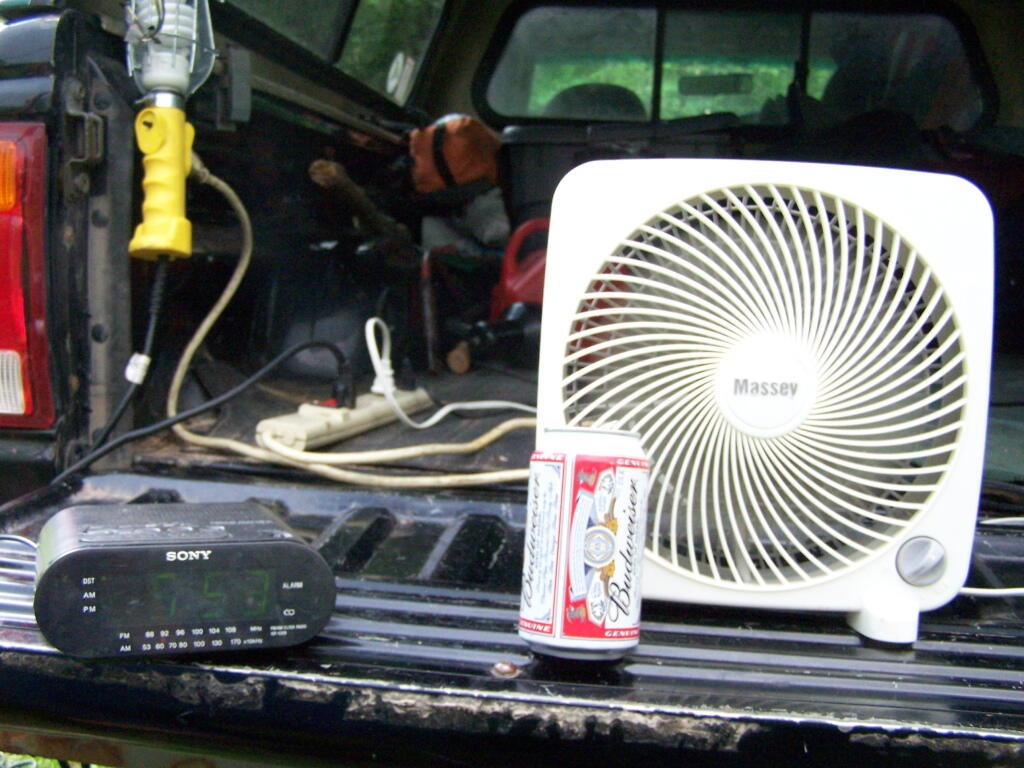Electricity
The second part of the series I’ve written on Truck Camping deals with the use of electricity and inverters. The first article is about the truck I currently use for camping and my future plans. A third article is coming soon.
A Must Have:
An Inverter for Household Electricity.
No truck camping set up is complete without having access to electricity. Foruntately, we live in an era with inverters, that quietly turn the 12v electricity from your truck’s electric system and battery into household electricity. They make no noise except for a low hum of the cooling fan in the inverter, that keeps the transformer from overheating. The silence is nice compared to noisy, smelly, and bulky gasoline powered generators some people use to power their camping equipment.
Inverters are now inexpensive. I am a fan of the Vector Inverters from Pepboys. I currently use a $75 dollar, 800 watt Vector inverter, which is large enough to power a small dorm-room refigerator or a microwave, although I don’t currently use either one of them. I previously had $35 dollar, 400 watt Vector inverter from spring 2004 to fall 2008, but I replaced it as I thought it was broken, even though the real problem was the electrical line from the truck battery to the inverter had broken, shorting out and blowing the in-line fuse.
Managing Your Battery Load:
Idle Your Engine Every 2-3 Hours for 10 Minutes.
One of the reasons that I bought the 800 watt inverter over the 400 watt inverter was for the built-in Digital LED voltage meter. Few things are more critical when camping, then to ensure you have sufficent cranking battery power to start up your truck in the morning. When the battery voltage gets below 12.0 volts unladen (ie. with your electrical load unplugged), you know you should start the truck up for 10 minutes to ensure the battery charge is maintained.
I’ve discovered that idling the truck for 10 minutes every 2-3 hours of moderate load (50-200 watts draw), ensures your battery remains a strong charge for starting even in cold weather. Their should be sufficent charge at all night for camping, and powering a florescent reading lamp, alarm clock, and other small devices (20-30 watts), although one should always start the truck up 10 minutes before bed to ensure the a sufficent charge come morning. For heavier temporary loads, like running a microwave or toaster, it’s probably best to idle your engine while in use, and few a few minutes there after to ensure a strong battery charge.
The colder the weather the quicker the discharge and the more power you need for starting, however if you keep the battery meter above 11.8 volts, there should be sufficent charge. Most inverters will shut off at 11.7 volts, however, this in many cases is not sufficent power for starting a cold engine, and risks damaging a typical truck starting battery through warping the electrode plates.
We are often educated to think idling a car is wasteful and consumes large amounts of gasoline. Indeed, idling a car without purpose, or even to warm up a car (for the engine’s sake), is wasteful of gas. However, idling to charge a battery uses minimal gasoline, my Ford Ranger uses maybe a 1/4 gallon of gasoline per day camping, just to generate electricity. Modern engines have little drag at idle, and therefore consume minimal energy running the alternator and other equipment when parked.
When in doubt, idle. It’s uses minimal gas and a lot easier then having to jump start in the morning.
Have A Back Up Plan:
For a Dead Battery.
Don’t go alone without a plan in case you have a dead battery in the morning. If your traveling with buddies who also have pickup trucks, then just make sure you have jumper cables. Be aware that smaller cars will not be able to neccessarly provide the power you need to jump start your truck, especially in cold weather due to the amperage requirements.
If your traveling alone, bring another battery to jump start. I currently use a Vector “Hot-Shot” Emergency Battery Jump Starter Kit that I bought for $40. It is a stand-alone battery that you charge in advance, and in case of emergency, you hook the jumper cables built into the “hot-shot” battery to your truck’s battery, providing the extra current needed to turn over your motor.
I currently store the “hot-shot” behind the driver’s seat in the cab. It’s 12 volt trickle charger cord is currently hard wired into the line that provides power from the main truck battery to the inverter. I unplug the “hot-shot” charger cord from the inverter power line when using the inverter, to keep the inverter from robbing electricity from the “hot-shot” when camping. Otherwise, when I’m driving, the “hot-shot” is constantly getting trickle charged at the proper voltage, controlled by the truck’s built in voltage regulator in the alternator.
Previously I had a transformer cord that I used to charge the “hot-shot” at home, but it got accidently destroyed, and I figure it’s smarter to have the “hot-shot” in the truck at all times and persistantly charged.
Future Set Up.
When I get my next pickup truck, a full-size truck, with more room under the hood, I plan to have a second battery installed under the hood. This will be a marine or deep cycle battery, designed to provide longer battery charge for powering the inverter, providing more electricity for longer periods of time. Likewise, due to the thicker plates of a deep cycle battery, it’s unlikely to be destroyed by the use of
The deep-cycle battery will be electrically isolated from the main starting battery using a device called a battery isolator, which is a block of diodes. While the truck’s alternator will provide electricity to charge the deep cycle and starting battery, the isolator prevents the deep cycle battery from stealing electricity from the starting battery.
In addition, I’m considering getting a set of low-cost 50-watt solar panels, to provide about 10 amps of 12vdc power through a solar charger, to feed into the battery isolator when the truck is off. That said, I’m not sure if it’s cost effective compared to simply idling the truck when the battery is low.


